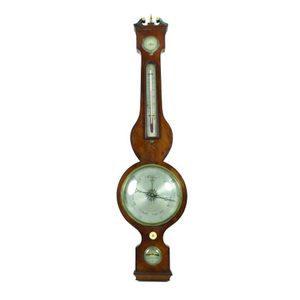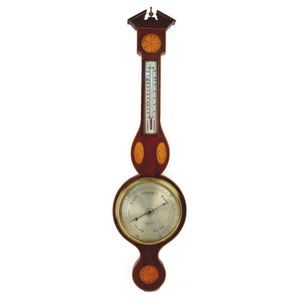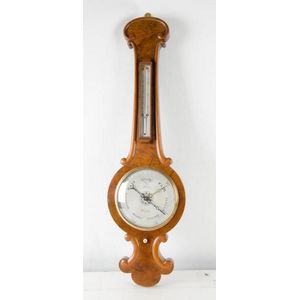George III Banjo Barometer by M. Pensa & Son
You must be a subscriber, and be logged in to view price and dealer details.
Subscribe Now to view actual auction price for this item
When you subscribe, you have the option of setting the currency in which to display prices to $Au, $US, $NZ or Stg.
- Mahogany - Mahogany is a dense, close grained red-coloured timber from the West Indies and Central America. It was first imported into Europe in the the early 18th century and its use continued through the 19th century. It was popular for furniture making because of its strength, the wide boards available, the distinctive grain on some boards, termed flame mahogany and the rich warm colour of the timber when it was polished.. The "flame" was produced where a limb grew out from the trunk of the tree, and this timber was usually sliced into veneers for feature panels on doors, backs and cornices.
Some terms used to describe mahogany relate to the country from which it originally came, such as "Cuban" mahogany, "Honduras" mahogany etc. However unless the wood has been tested the names assigned are more a selling feature, rather than a true indication of the timber's origin. - Satinwood - Satinwood is a dense pale gold coloured timber that was imported into Britain in the second half of the 18th century, and early 19th centuries from the East Indies and the West Indies. The name derives from the satin-like surface sheen when the timber is polished.
It was used in the solid, as a veneer and in inlays. As well as furniture, satinwood was used for making musical instruments, barometers, boxes and clocks.
It will usually be found on only the very best quality objects, presumably because of of its cost at the time. - Ebony - Ebony is a close grained timber, black in colour. It has a fine texture which can be polished to a high gloss, making it suitable for venereering, inlay and stringing and its use as solid timber is resticted to small decorative items and ornamental decoration, such as chess pieces and musical instrument parts. The term "ebonised" means "faux ebony", timber that has been darkened during the polishing process to resemble ebony.
- George Iii - George III (1738 - 1820) was King of Great Britain and Ireland from 1760 to 1820.
This item has been included into following indexes:
- barometers, period or origin - Georgian, Regency, Sheraton 51
-
barometers, type
- banjo 135
- barometers with thermometer 122
Visually similar items

A Regency mahogany cased banjo barometer by Peter Canova of Halesworth, the case with swan neck pediment, set with a Dry/Damp gauge, thermometer, silvered dial barometer and positioning level with engraved maker's name, ivory adjusting knob. Height 99.5 cm

A good Sheraton Revival banjo barometer, the mahogany body with shell, star and fine border inlays, the silvered dials with Arabic numerals, named 'Harrison's Opticians, The Arcades, Birmingham'. Length 99 cm

English mahogany banjo barometer by 'P. Corti, Exeter'. Corti of 5 Market Street, Exeter is listed as a manufacturer of barometers in 1850. Fully restored. 92 cm.

Banjo barometer, mahogany case, by Budds Huntingdon, height 95 cm
